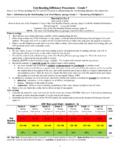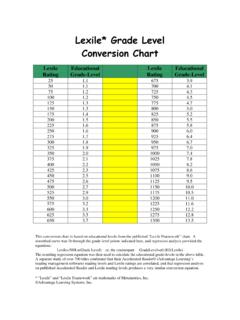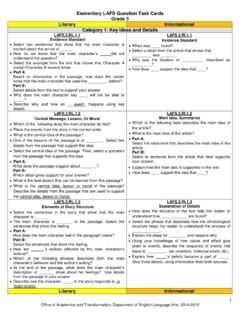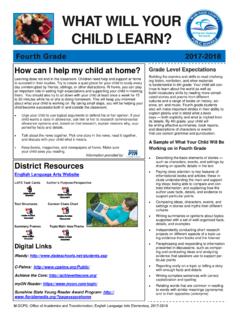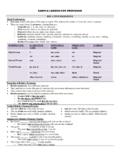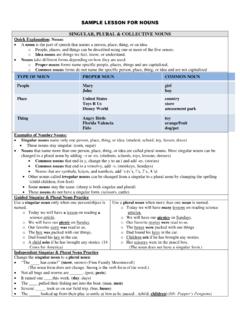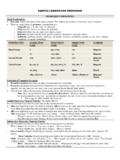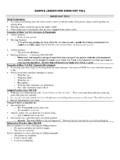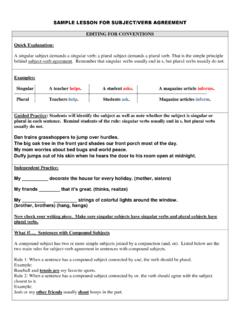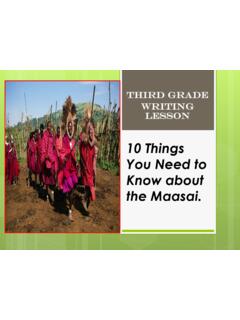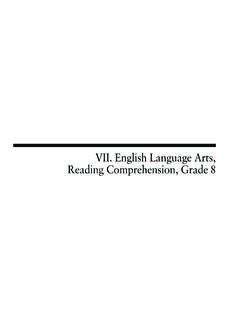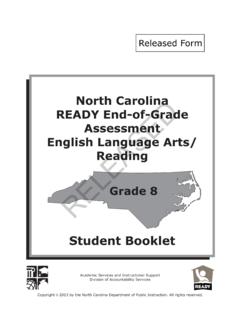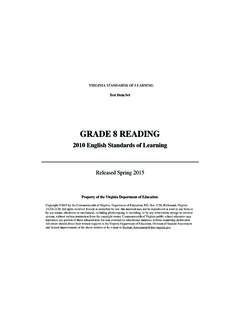Transcription of Text Reading Efficiency Procedures - Grade 8
1 1 Text Reading Efficiency Procedures - Grade 8 Please read Weekly Briefing #17325 prior to administering the Text Reading Efficiency Placement Test. Part I: Administering the Oral Reading Test (Oral Fluency passage Grade 8 Ice Skating ) Materials for Part I Stop watch or timer Front-to-back sets of the Examiner s Copy of the Oral Reading Fluency passage (page 3) with the Student Performance Record (page 6) 1 copy per student 1 Student Copy of the Oral Reading Fluency passage (page 4) NOTE: The same Oral Reading Fluency passage is used for Part I and Part II Prior to testing: 1.
2 Read the test and scoring directions carefully before administering the test. 2. Make front-to-back sets of the Examiner s Copy (page 3) with the Student Performance Record (page 6) for each student. This paper will serve as a place for the test administrator to make notes and score the student s responses. 3. Plan to test the student in a quiet area away from other students. Give each student one minute for Reading , plus you will need time at the end to calculate scores. During testing: 1. Put the student at ease. Tell him or her that Reading aloud is an important part of Reading , and that you will be listening and taking notes as he or she reads a story for one minute.
3 2. Provide the student with a Student Copy of the Oral Reading Fluency passage (page 4). Allow the student an opportunity to pre-read the passage prior to testing. 3. Read the SCRIPT on the Examiner s Copy verbatim. The student will read out loud for one minute. 4. Record the number of word call errors the student makes while Reading . An error includes any word that is omitted, mispronounced, or substituted for another word. Words read correctly that are repeated more than once, errors self-corrected by the student, words inserted by the student that do not appear in the text, and words mispronounced due to dialect or speech impairments are not counted as errors.
4 They do, however, impact the final score since they slow the student down and reduce the number of words that are read correctly in one minute (Shinn, 1989). 5. In addition to listening for word call errors, determine whether the student is Reading for prosody by considering: phrasing: intonation, stress (emphasis on syllables), and pausing; syntax: adherence to the order of words; expression: ability to convey feeling, modulation of the voice, change in pitch or tone of voice 6. Mark in the text where the student leaves off at the end of one minute. After testing: 1. Calculate the student s numerical score for words correct per minute (WCPM).
5 That score is derived by subtracting the number of errors from the number of words read in one minute. 2. Determine the risk level based on the WCPM read by the student and record on the Student Performance Record (page 6). ORF Risk Level Chart - Grades 6 - 12 Oral Reading Fluency Grade 6 Grade 7 Grade 8 Grade 9 Grade 10 Grade 11 Grade 12 Risk Level Assessment 3 Assessment 3 Assessment 3 Assessment 3 Assessment 3 Assessment 3 Assessment 3 0-90 0-97 0-103 0-103 0-103 0-103 0-103 HR 91-121 98-126 104-126 104-126 104-126 104-126 104-126 MR 122+ 127+ 127+ 127+ 127+ 127+ 127+ LR HR - High Risk: Seriously below Grade level and in need of substantial intervention; MR - Moderate Risk: Moderately below Grade level and in need of substantial intervention.
6 LR - Low Risk: At Grade level but in need of intervention 3. Assign a ranking based on the overall observations of the students : 2 phrasing: intonation, stress (emphasis on syllables), and pausing; syntax: adherence to the order of words; expression: ability to convey feeling, modulation of the voice, change in pitch or tone of voice 4. Record the student s level on the Student Performance Record (page 6) for Oral Reading for Prosody according to the following Four-point fluency scale. Oral Reading for Prosody - Four-Point Fluency Scale Level 4 Reads primarily in larger, meaningful phrase groups.
7 Although some regressions, repetitions, and deviations from the text may be present, those do not appear to detract from the overall structure of the story. Preservation of the author s syntax is consistent. Some or most of the story is read with expressive interpretation. Level 3 Reads primarily in three- or four-word phrase groups. Some smaller groupings may be present. However, the majority of phrasing seems appropriate and preserves the syntax of the author. Little or no expressive interpretation is present. Level 2 Reads primarily in two-word phrases with some three- and four-word groupings.
8 Some word-by-word Reading may be present. Word groupings may seem awkward and unrelated to larger context of sentence or passage. Level 1 Reads primarily word-by-word. Occasionally two- or three-word phrases may occur, but these are infrequent and/or do not preserve meaningful syntax. Part II: Administering the Silent Reading Test Materials for Part II Blank notebook paper for each student Front-to-back class set of the Student Copy of the Oral Reading Fluency passage (page 4) with the Comprehension Questions for the Reading Fluency passage (page 5) Prior to testing: 1.
9 Read the test and scoring directions carefully before administering the test. 2. The Silent Reading test (pages 4 5) of comprehension may be administered in a whole group setting. 3. Provide student with a front-to-back Student Copy of the Oral Reading Fluency passage and questions (pages 4 5). During testing: 1. Put the student at ease. Tell him or her that Reading silently is an important part of Reading , and that he or she will be Reading silently and answering a few questions about the passage previously read. 2. Give the student 5 8 minutes to silently read the passage and answer the comprehension questions on a separate sheet of notebook paper.
10 (Optional) In addition to answering comprehension questions 1 5, ask the student to retell the story orally. Allow the student to refer to the passage while he or she responds orally. After testing: 1. Collect the student notebook papers. Part III: Determining Appropriate Placement into Intensive Reading classes. Materials for Part III Front-to-back sets of the Examiner s Copy of the Oral Reading Fluency passage (page 3) with the Student Performance Record (page 6) 1 copy per student NOTE: This is the same copy used in Part I 1. Use student performance results to determine the appropriate placement into Intensive Reading classes.
